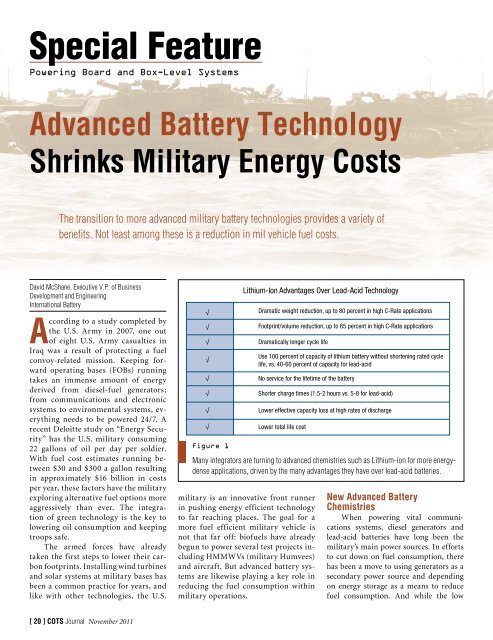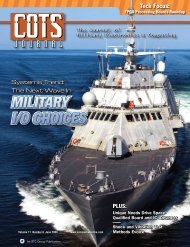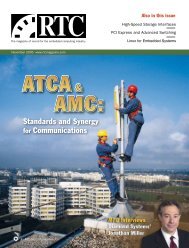Inrush Current Control Technology Boosts Power Converter Reliability
Inrush Current Control Technology Boosts Power Converter Reliability
Inrush Current Control Technology Boosts Power Converter Reliability
Create successful ePaper yourself
Turn your PDF publications into a flip-book with our unique Google optimized e-Paper software.
Special Feature<br />
<strong>Power</strong>ing Board and Box-Level Systems<br />
Advanced Battery <strong>Technology</strong><br />
Shrinks Military Energy Costs<br />
The transition to more advanced military battery technologies provides a variety of<br />
benefits. Not least among these is a reduction in mil vehicle fuel costs.<br />
David McShane, Executive V.P. of Business<br />
Development and Engineering<br />
International Battery<br />
According to a study completed by<br />
the U.S. Army in 2007, one out<br />
of eight U.S. Army casualties in<br />
Iraq was a result of protecting a fuel<br />
convoy-related mission. Keeping forward<br />
operating bases (FOBs) running<br />
takes an immense amount of energy<br />
derived from diesel-fuel generators;<br />
from communications and electronic<br />
systems to environmental systems, everything<br />
needs to be powered 24/7. A<br />
recent Deloitte study on “Energy Security”<br />
has the U.S. military consuming<br />
22 gallons of oil per day per soldier.<br />
With fuel cost estimates running between<br />
$30 and $300 a gallon resulting<br />
in approximately $16 billion in costs<br />
per year, these factors have the military<br />
exploring alternative fuel options more<br />
aggressively than ever. The integration<br />
of green technology is the key to<br />
lowering oil consumption and keeping<br />
troops safe.<br />
The armed forces have already<br />
taken the first steps to lower their carbon<br />
footprints. Installing wind turbines<br />
and solar systems at military bases has<br />
been a common practice for years, and<br />
like with other technologies, the U.S.<br />
[ 20 ] COTS Journal November 2011<br />
√<br />
√<br />
√<br />
√<br />
√<br />
√<br />
√<br />
√<br />
Figure 1<br />
Lithium-Ion Advantages Over Lead-Acid <strong>Technology</strong><br />
military is an innovative front runner<br />
in pushing energy efficient technology<br />
to far reaching places. The goal for a<br />
more fuel efficient military vehicle is<br />
not that far off: biofuels have already<br />
begun to power several test projects including<br />
HMMWVs (military Humvees)<br />
and aircraft. But advanced battery systems<br />
are likewise playing a key role in<br />
reducing the fuel consumption within<br />
military operations.<br />
Dramatic weight reduction, up to 80 percent in high C-Rate applications<br />
Footprint/volume reduction, up to 65 percent in high C-Rate applications<br />
Dramatically longer cycle life<br />
Use 100 percent of capacity of lithium battery without shortening rated cycle<br />
life, vs. 40-60 percent of capacity for lead-acid<br />
No service for the lifetime of the battery<br />
Shorter charge times (1.5-2 hours vs. 5-8 for lead-acid)<br />
Lower effective capacity loss at high rates of discharge<br />
Lower total life cost<br />
Many integrators are turning to advanced chemistries such as Lithium-ion for more energydense<br />
applications, driven by the many advantages they have over lead-acid batteries.<br />
New Advanced Battery<br />
Chemistries<br />
When powering vital communications<br />
systems, diesel generators and<br />
lead-acid batteries have long been the<br />
military’s main power sources. In efforts<br />
to cut down on fuel consumption, there<br />
has been a move to using generators as a<br />
secondary power source and depending<br />
on energy storage as a means to reduce<br />
fuel consumption. And while the low






